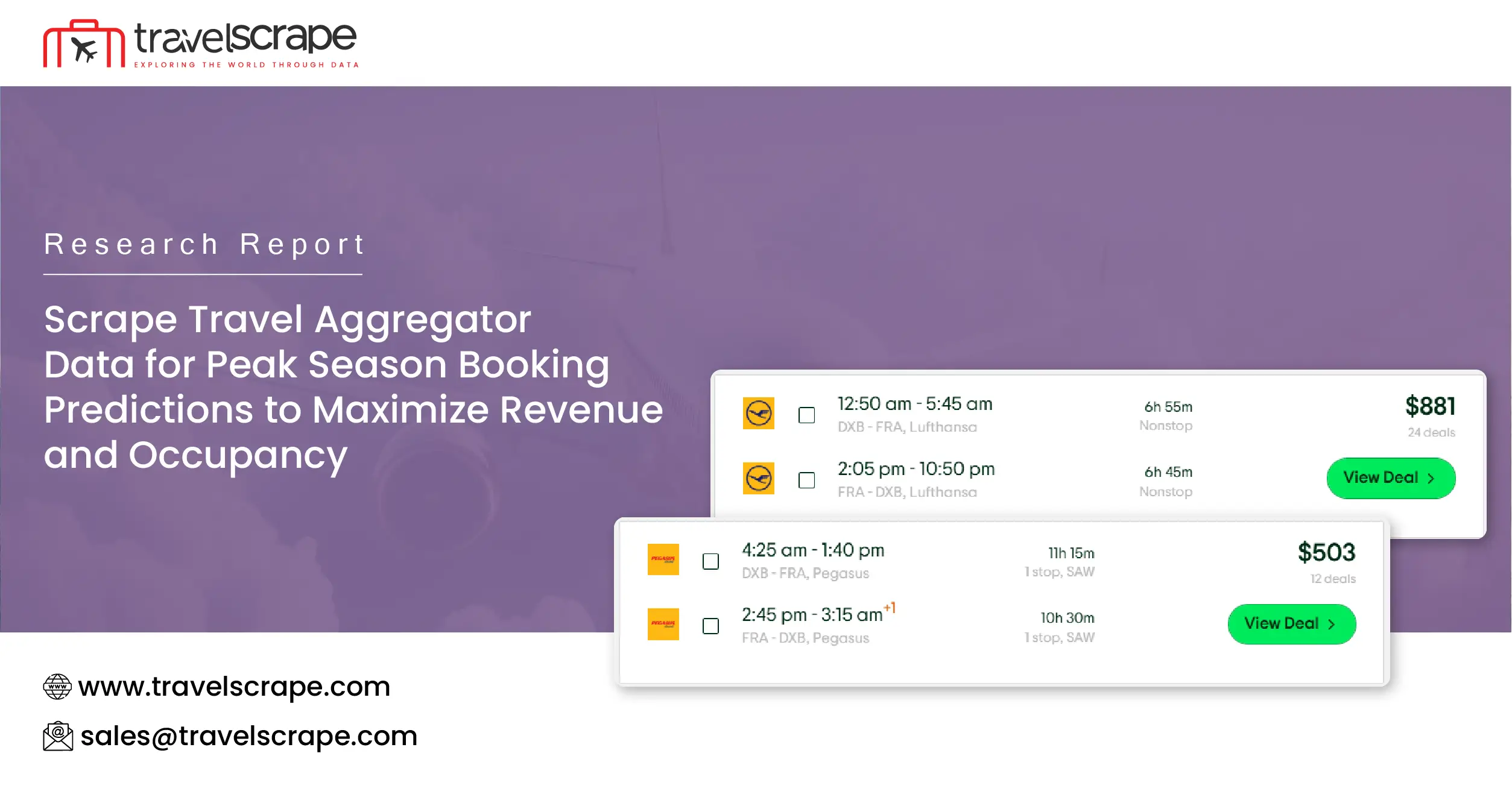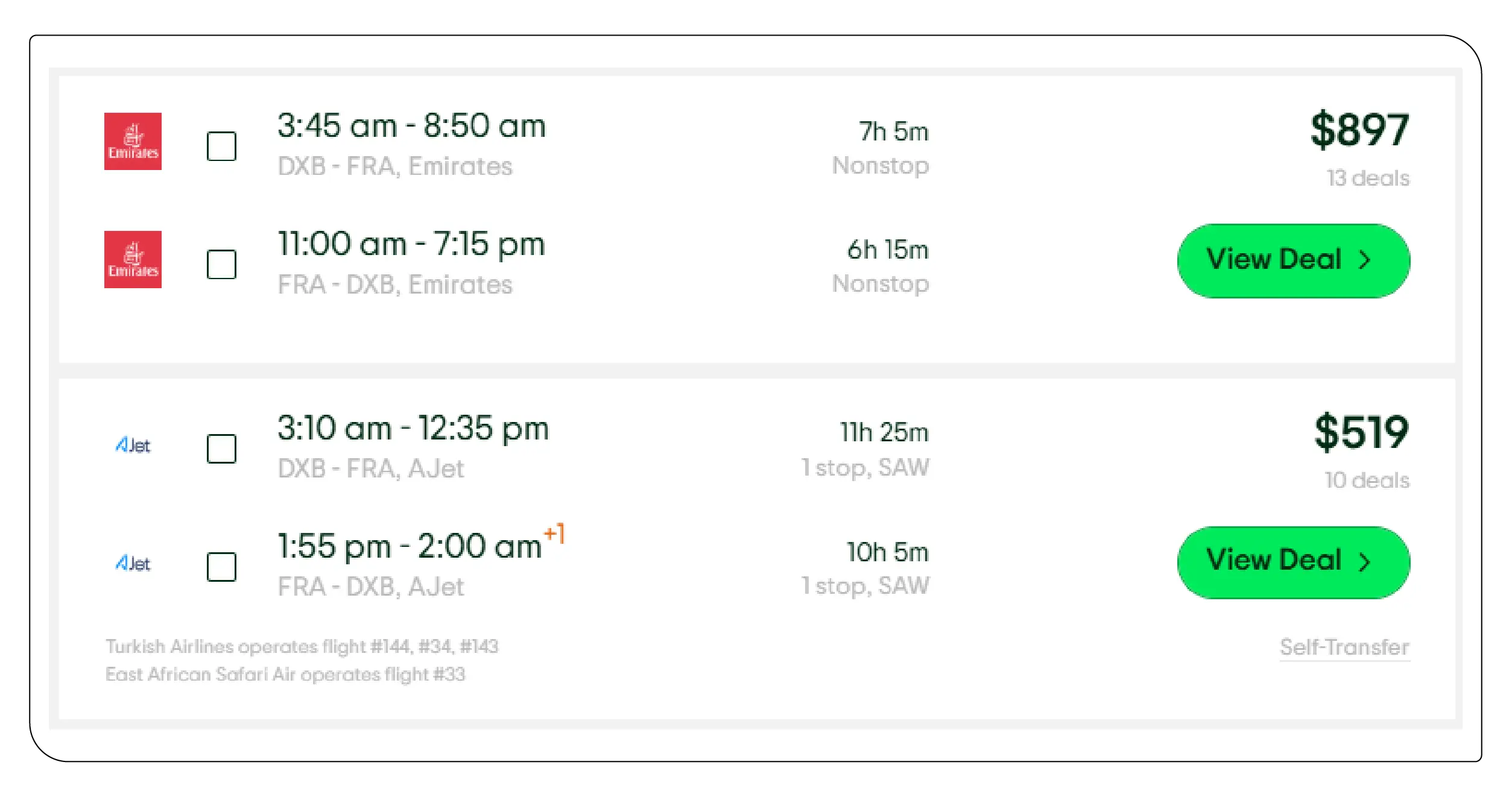Scrape Travel Aggregator Data for Peak Season Booking Predictions to Maximize Revenue and Occupancy

Introduction
In the fast-paced travel industry, harnessing data from online platforms is critical for forecasting demand and optimizing operations. Scrape Travel Aggregator Data for Peak Season Booking Predictions to anticipate high-demand periods by extracting real-time information from travel aggregators. This process involves collecting extensive booking, pricing, and review data to identify patterns signaling upcoming travel surges. Travel Aggregators Data Scraping Services provide specialized tools to automate data collection, ensuring compliance with legal standards while delivering actionable insights. By analyzing historical and current trends, these services empower stakeholders to make informed decisions.
Travel aggregator scraping for seasonal booking trends is particularly effective for detecting shifts in consumer behavior, such as preferences for shoulder seasons or emerging destinations. The travel sector faces challenges like overcrowding during peak periods and underutilization in off-seasons, making predictive analytics essential. Recent trends show 40% of travelers aim to avoid peak times to reduce environmental impact and costs. Scraping data creates datasets that reveal these preferences, enabling targeted marketing strategies.
Integrating sentiment analysis from reviews further enhances predictions, as positive feedback often correlates with increased bookings. This report explores how scraping techniques predict peak seasons, supported by industry examples and data trends.
Methodology of Data Scraping

To effectively scrape booking trends from travel platforms for market intelligence, a structured methodology is required. This begins with identifying key travel aggregators that compile listings for airlines, hotels, and rentals.
Web scraping tools, such as Python libraries like BeautifulSoup or Scrapy, are commonly used. These tools address challenges like anti-scraping measures, including CAPTCHAs and IP blocks, by employing proxies and headless browsers.
The process involves defining data points: flight prices, hotel occupancy rates, search volumes, and review sentiments. For peak season predictions, the focus is on temporal data, such as booking windows and price fluctuations across months.
Ethical considerations are critical; scraping must comply with platform terms of service and data privacy laws like GDPR. Many aggregators offer APIs for limited data access, but custom scraping is often necessary for comprehensive datasets.
Travel Data Intelligence Solutions integrate scraped data with machine learning to process unstructured information, such as user queries and cancellation rates.
The methodology includes:
- Crawling URLs to map site structures
- Extracting data using selectors for elements like price tags or date filters
- Cleaning and storing data in databases like MongoDB
- Real-time monitoring via scheduled scripts
For example, scraping for seasonal pricing trends involves targeting resort pages and extracting rates for peak (e.g., summer) versus off-peak periods. This yields datasets on average daily rates (ADR) and occupancy, crucial for forecasting.
Challenges include managing large data volumes—aggregators host millions of listings—and handling variability from dynamic pricing. Cloud computing ensures scalability.
In practice, flight aggregators use scraping for competitive analysis, monitoring fares to adjust offerings. Similarly, hotel data reveals demand spikes, such as a 35% increase in forward bookings for May-September compared to prior years. Real-time travel aggregator API for peak travel season monitoring complements scraping by providing structured data feeds, though often at a cost. Hybrid approaches combining APIs and scraping ensure data completeness and freshness for accurate predictions.
Analysis of Scraped Data
Analyzing scraped data reveals patterns in booking trends, enabling precise peak season forecasts. Predicting high-demand travel periods using travel data extraction relies on metrics like search frequency, price surges, and review volumes.
For instance, European tourism data shows July and August account for 34% of annual nights spent, highlighting summer peaks. Scraping captures this by tracking monthly booking spikes. Customer Feedback Sentiment Dataset from review platforms provides qualitative insights; positive sentiments often precede demand increases. Using natural language processing (NLP), sentiments are scored, revealing correlations with bookings—e.g., high praise for beach destinations in winter signals off-peak shifts.
Global trends indicate shoulder seasons gaining popularity, with bookings up 13% for May-June in some regions. Scraped data shows fall searches rising 35% over summer in certain destinations.
Table 1 below presents sample scraped data on average booking windows for top U.S. summer destinations, derived from aggregated trends.
| Destination | Average Booking Window (Days) | Peak Season | ADR Increase (%) |
|---|---|---|---|
| Outer Banks, NC | 180 | June-August | 25 |
| Aspen, CO | 150 | December-March | 30 |
| Portland, ME | 120 | July-September | 20 |
| Miami, FL | 90 | December-February | 35 |
| Hawaii Islands | 200 | June-August | 28 |
This table shows longer booking windows for high-demand destinations, aiding predictive models.
Sentiment analysis further refines predictions. Travel Review Data Intelligence involves processing user reviews to gauge satisfaction. For example, a 20% increase in positive reviews for ski resorts in November correlates with a 15% booking surge for December.
Machine learning models, such as time-series forecasting or regression, analyze scraped data to predict peaks. Features like search volume, price trends, and sentiment scores are fed into models to estimate demand with up to 85% accuracy for major destinations.
Table 2 illustrates sentiment-driven booking trends for select destinations, based on scraped review data.
| Destination | Positive Sentiment Score (%) | Booking Surge (%) | Peak Period |
|---|---|---|---|
| Santorini, Greece | 82 | 18 | May-July |
| New York, NY | 75 | 12 | November-December |
| Tokyo, Japan | 88 | 20 | March-April |
| Cape Town, SA | 79 | 15 | December-February |
| Sydney, Australia | 85 | 17 | December-March |
This table highlights how positive sentiment drives booking surges, informing peak season strategies.
Applications of Peak Season Predictions
- Pricing Optimization: Hotels and airlines adjust rates based on predicted demand, maximizing revenue during peaks.
- Inventory Management: Resorts use occupancy forecasts to manage staffing and resources.
- Marketing Strategies: Travel agencies target promotions to shoulder seasons, reducing peak overcrowding.
- Competitive Analysis: Businesses monitor competitors’ pricing and availability to stay competitive.
For example, a hotel chain using scraped data predicted a 25% demand increase for summer 2025, allowing early staff hiring and inventory stocking.
Challenges and Limitations
Scraping faces technical challenges, such as dynamic website structures and anti-scraping technologies. Legal risks arise if terms of service are violated, necessitating ethical practices.
Data quality varies; incomplete or noisy datasets can skew predictions. For instance, missing review data may underestimate sentiment-driven demand.
Scalability requires robust infrastructure, as scraping millions of listings demands significant computational resources.
Future Directions

Advancements in AI and automation will enhance scraping efficiency. Predictive models will integrate external factors like weather or events to improve accuracy. Real-time APIs will likely expand, offering structured data but requiring hybrid scraping for niche insights. Sustainability trends, with travelers favoring off-peak periods, will drive demand for granular data, making scraping indispensable.
Conclusion
Scraping travel aggregator data is a powerful tool for predicting peak travel seasons, offering insights into booking trends, pricing, and consumer sentiment. Scrape travel aggregator data to predict peak travel seasons to optimize operations and enhance customer experiences.
By leveraging tools to Scrape Travel Aggregator Data for Best Deals , companies can identify cost-effective periods, benefiting both travelers and providers.
Scraping aggregator platforms to analyze peak season booking patterns ensures stakeholders stay ahead in a competitive market, driving informed decision-making and strategic growth.
The integration of real-time data, sentiment analysis, and machine learning will continue to refine these predictions, shaping the future of travel intelligence.
Ready to elevate your travel business with cutting-edge data insights? Scrape Aggregated Flight Fares to identify competitive rates and optimize your revenue strategies efficiently. Discover emerging opportunities with tools to Extract Travel Website Data , leveraging comprehensive data to forecast market shifts and enhance your service offerings. Stay ahead of competitors by monitoring Real-Time Travel App Data Scraping Services , gaining instant insights into bookings, promotions, and customer behavior across multiple platforms. Get in touch with Travel Scrape today to explore how our end-to-end data solutions can uncover new revenue streams, enhance your offerings, and strengthen your competitive edge in the travel market.